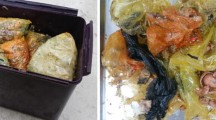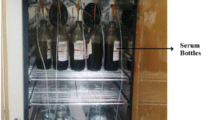Abstract
This work aims to valorize food waste available in the Umbria region (Italy). According to the anaerobic digestion, the resulting biogas production can be divided into two periods. In the first one, 22 L of a mixture were digested during the initial test days without daily charge, and in the second period, the daily mixture was inputted ensuing a determined organic loading rate equal to 1.5 g VS/L/day. Globally, the results indicated that biogas production has started since the first test day and has increased steadily in the first two days until it reaches its peak on the 2nd day before declining. The cumulative biogas volume produced within the 41 days of the experimentation test was 0.269 Nm3/Kg VS. As a result, bio-methane percentages from the total biogas volume were, respectively, 66.67% and 56.22% during the first and second periods. The anaerobic digestion of this mixture has shown higher alkalinity to resist against the acidity pH of the food waste.
Access provided by Autonomous University of Puebla. Download chapter PDF
Similar content being viewed by others
Keywords
1 Introduction
In the context of renewable energy, mainly from anaerobic digestion (AD), the I-REXFO project in the European Union (EU) designs a modern business model to radically reduce the number of food wastes. It will remove the barriers that obstruct the use of food residues in biogas plants. I-REXFO will achieve an overall reduction of 17.103 tons/year of food wastes land-filled during the project duration and in the after-life phase. This will correspond to a large reduction of 41,000 tons of CO2 equivalent emissions. I-REXFO will uptake good practices from other EU countries (Denmark), and it will demonstrate the model in the Umbria region (Italy) and eventually transfer it to other Italian regions and EU countries (Liberti et al. 2018). The aim of this study is to valorize the food wastes available in the region of Umbria by AD, with the use of abundant primary digester as inoculums to improve the production. The inoculums are composed of digested agricultural wastes. The project’s context is to enrich the researches on the valorization of this abundant waste, especially that these wastes are characterized by higher acidity which is the main inhibitor that affects the anaerobic digestion (Wang et al. 2014).
2 Methods and Materials
The fermentation of the food wastes under constant mesophilic conditions (35 ℃) exceeded the thermophilic digesters in terms of the biogas and in preventing the production of the inhibitor (Zamanzadeh et al. 2016). The AD test was done in continuously stirred tank reactors (CSTR). The feeding step was affected as following: The first step was to supply the mixture which is composed of the primary digester and food wastes in the bioreactor till the steady state of production reaches. Then, daily flow (Q) of charge and discharge of the mixture and digestate, respectively, start. The flow Q was equal to 0.4 (L/day) and was calculated according to the organic loading rate (OLR). In this work, the (OLR) will be fixed at 1.5 g VS/L/day as an optimal feeding at mesophilic conditions (Liu et al. 2017). The used mixture is composed of different percentages of the primary digester and food waste, ensuing the substrate/inoculums (S/I) ratio based on volatile solid (VS) mass. Daily pH control for both charge/discharge and daily biogas production was done. Before the AD, the used materials were subjected to proximate analysis that allowed obtaining humidity (H) [%] and volatile matter (VS) [%]. The analysis and the daily control tests were done in the Analysis Lab of the Biomass Research Center (Italy) as described in the previous work of Liberti et al. (2019).
where VT is the total volume (22 L), and (VS)T is the total (VS) mass in the mixture (in g/L).
3 Results and Discussions
3.1 Characterizations of the Substrates
The table below (Table 1) regrouped the physico-chemical proprieties of the used substrates in this test. The preparation of the mixture was according to the (I/S) ratio. Ref. (Holliger et al. 2016) mentioned that (I/S) should, for most applications, be between 2 and 4. In this study, 12% of food waste and 88% of primary digester give an optimal ratio equal to 3. The higher humidity of the mixture made the AD environment wet. Thus, it facilitates the charge and discharge. Besides, the VS (%) indicated the organic fraction in the used materials. The pH value of the food waste was characterized by a very higher acidic value arranged between 4.5 and 6.8. However, the charge mixture pH was around 7.
3.2 Daily and Cumulative Biogas Production
Figures 1 and 2 showed the daily and cumulative biogas productions from the total mixture volume. The fermentation test lasted 41 days under the daily controlled condition of T (35 ℃) and pH (around 7). The daily biogas production (see Fig. 1) can be divided into two parts. The first one is from the set-up of the fermentation test until the 10th test day. In this period, the bio-digester is feeding with the mixture without a daily charge. In the first two days, a very higher speed of biogas production was shown. The rapid production was especially due to the absence of inhibitor concentration of oxygen that prevents the process and the higher adaptation of the bacteria in the medium (Okonkwo 2018). In this study, on the 2nd test day, the peak of production was reached. Thus, the bacteria have acted on the maximum possible amount of organic materials. After this and until the 10th day, the production drops as all the excess organic materials have been converted to biogas. In the first period, the initial biogas volume contains 66.67% of CH4. The second part of this curve is the rest of the curve, in this period, daily feeding of the mixture has occurred, according to the determined flow (Q). The curve showed an almost steady state in the production of the biogas in comparison with the first period. The absence of the fluctuation during this period is a consequence of the stability of the anaerobic environment that gives an appropriate biogas forming condition. During this period, the bio-methane percentage was around 56.22% of the total biogas volume. Figure 2 illustrated the cumulative biogas production during the test period. As a result of this work, the produced cumulative quantity of biogas was equal to 0.269 Nm3/Kg SV. Food waste is perfectly suitable for the anaerobic digestion because it contains a suitable composition for the fermentation, such as proteins, carbohydrates, and lipids (Morales-Polo et al. 2018).
3.3 Daily pH Control
During the fermentation period, the pH value was controlled for both charge and discharge to avoid the negative effects of the acidic value. The controlled discharge pH has shown almost neutral value for pH between 6.93 and 7.64. (Yang 2015) mentioned that AD of food wastes had been widely studied, but one of the serious problems was the pH drop owed to the rapid accumulation of organic acids during the digestion process which inhibits the process and prevents the activity of methanogenesis bacteria. The present fermentation environment has revealed a higher buffering capacity which can resist the change of pH value during the AD process. The buffer capacity (alkalinity) of the system is important to avoid a sudden drop in pH which affects the biogas production (Demitry and McFarland 2015).
4 Conclusion
From the present mesophilic and continuous experimentation, it can be inferred that the used mixture can be employed as suitable feedstock for important biogas production, especially that there was no pH dropping, which can be considered the main inhibitor in the anaerobic digestion of the food waste.
References
Demitry, M.E., McFarland, M.J.: Defining full-scale anaerobic digestion stability: the case of central weber sewer improvement district. Environ. Pollut. 4(2) (févr 2015)
Holliger, C., et al.: Towards a standardization of biomethane potential tests. Water Sci. Technol. 74(11), 2515–2522 (déc 2016). https://doi.org/10.2166/wst.2016.336
Liberti, F., Pistolesi, V., Massoli, S., Bartocci, P., Bidini, G., Fantozzi, F.: i-REXFO LIFE: an innovative business model to reduce food waste. Energy Procedia. 9 (2018)
Liberti, F., et al.: An incubation system to enhance biogas and methane production: a case study of an existing biogas plant in Umbria, Italy. Processes 7(2), 925 (déc 2019). https://doi.org/10.3390/pr7120925
Liu, C., Wang, W., Anwar, N., Ma, Z., Liu, G., Zhang, R.: Effect of organic loading rate on anaerobic digestion of food waste under mesophilic and thermophilic conditions. Energy Fuels 31(3), 2976–2984, (mars 2017). https://doi.org/10.1021/acs.energyfuels.7b00018
Morales-Polo, C., del Mar Cledera-Castro, M., Moratilla Soria, B.Y.: Reviewing the anaerobic digestion of food waste: from waste generation and anaerobic process to its perspectives. Appl. Sci. 8(10), 1804 (Oct 2018). https://doi.org/10.3390/app8101804
Okonkwo, U.C.: Comparative study of the optimal ratio of biogas production from various organic wastes and weeds for digester/restarted digester. 18 (2018)
Wang, K., Yin, J., Shen, D., Li, N.: Anaerobic digestion of food waste for volatile fatty acids (VFAs) production with different types of inoculum: Effect of pH. Bioresour. Technol. 161, 395–401 (juin 2014). https://doi.org/10.1016/j.biortech.2014.03.088
Yang, L.: Enhancing biogas generation performance from food wastes by high-solids thermophilic anaerobic digestion: effect of pH adjustment. Int. Biodeterior. 7 (2015)
Zamanzadeh, M., Hagen, L.H., Svensson, K., Linjordet, R., Horn, S.J.: Anaerobic digestion of food waste—effect of recirculation and temperature on performance and microbiology. Water Res. 96, 246–254 (juin 2016). https://doi.org/10.1016/j.watres.2016.03.058
Author information
Authors and Affiliations
Corresponding author
Editor information
Editors and Affiliations
Rights and permissions
Copyright information
© 2022 The Author(s), under exclusive license to Springer Nature Switzerland AG
About this chapter
Cite this chapter
Mouftahi, M., Bartocci, P., Tlili, N., Hidouri, N., Liberti, F., Fantozzi, F. (2022). Pilot-Scale Anaerobic Digestion of Food Waste Under Mesophilic Conditions: A Case-Study at Umbria Region (Italy). In: Naddeo, V., Choo, KH., Ksibi, M. (eds) Water-Energy-Nexus in the Ecological Transition. Advances in Science, Technology & Innovation. Springer, Cham. https://doi.org/10.1007/978-3-031-00808-5_97
Download citation
DOI: https://doi.org/10.1007/978-3-031-00808-5_97
Published:
Publisher Name: Springer, Cham
Print ISBN: 978-3-031-00807-8
Online ISBN: 978-3-031-00808-5
eBook Packages: Earth and Environmental ScienceEarth and Environmental Science (R0)






